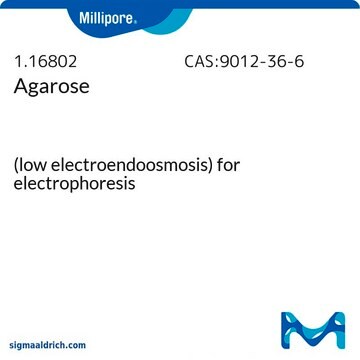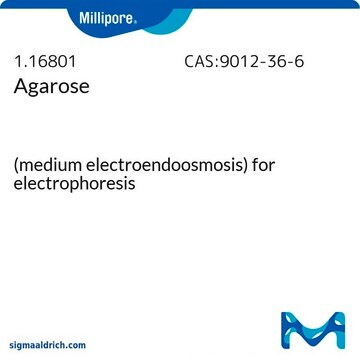A0576
Agarose
Low EEO
Synonym(s):
3,6-Anhydro-α-L-galacto-β-D-galactan, Agarose LE
Select a Size
Select a Size
About This Item
Recommended Products
Quality Level
type
Type I-B
form
powder
technique(s)
electrophoresis: suitable
impurities
≤7% water
ash
≤0.25%
turbidity
≤4 NTU (1.5% gel)
EEO
≤0.12
mp
86.5-89.5 °C
transition temp
gel point 36 °C ±1.5 °C (1.5% gel)
Looking for similar products? Visit Product Comparison Guide
General description
Application
- to form the photosynthetic slab
- in comparative study, to compare it with native agar, and agarose of Gracilaria dura
- to estimate the amino acid concentrations in agarose and agar samples
- as immobilisation substrates for enzyme immobilisation
- for separating high molecular weight nucleic acids at low gel concentrations
Biochem/physiol Actions
Analysis Note
Sulfate content - used as an indicator of purity, since sulfate is the major ionic group present.
Gel strength - the force that must be applied to a gel to cause it to fracture.
Gel point - the temperature at which an aqueous agarose solution forms a gel as it cools. Agarose solutions exhibit hysteresis in the liquid-to-gel transition - that is, their gel point is not the same as their melting temperature.
Electroendosmosis (EEO) - a movement of liquid through the gel. Anionic groups in an agarose gel are affixed to the matrix and cannot move, but dissociable counter cations can migrate toward the cathode in the matrix, giving rise to EEO. Since electrophoretic movement of biopolymers is usually toward the anode, EEO can disrupt separations because of internal convection.
Storage Class
11 - Combustible Solids
wgk_germany
WGK 3
flash_point_f
Not applicable
flash_point_c
Not applicable
ppe
Eyeshields, Gloves, type N95 (US)
Choose from one of the most recent versions:
Certificates of Analysis (COA)
Don't see the Right Version?
If you require a particular version, you can look up a specific certificate by the Lot or Batch number.
Already Own This Product?
Find documentation for the products that you have recently purchased in the Document Library.
Customers Also Viewed
Our team of scientists has experience in all areas of research including Life Science, Material Science, Chemical Synthesis, Chromatography, Analytical and many others.
Contact Technical Service


